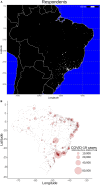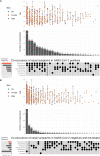Olfactory Dysfunction in Frontline Health Care Professionals During COVID-19 Pandemic in Brazil
- PMID: 33767631
- PMCID: PMC7985267
- DOI: 10.3389/fphys.2021.622987
Olfactory Dysfunction in Frontline Health Care Professionals During COVID-19 Pandemic in Brazil
Abstract
Upper respiratory viral infections can decrease the sense of smell either by inflammatory restriction of nasal airflow that carries the odorant molecules or through interference in olfactory sensory neuron function. During the coronavirus disease 2019 (COVID-19) pandemic, triggered by severe acute respiratory syndrome coronavirus 2 (SARS-CoV-2), worldwide reports of severe smell loss (anosmia/hyposmia) revealed a different type of olfactory dysfunction associated with respiratory virus infection. Since self-reported perception of smell is subjective and SARS-CoV-2 exposure is variable in the general population, we aimed to study a population that would be more homogeneously exposed to the virus. Here, we investigated the prevalence of olfactory loss in frontline health professionals diagnosed with COVID-19 in Brazil, one of the major epicenters of the disease. We also analyzed the rate of olfactory function recovery and the particular characteristics of olfactory deficit in this population. A widely disclosed cross-sectional online survey directed to health care workers was developed by a group of researchers to collect data concerning demographic information, general symptoms, otolaryngological symptoms, comorbidities, and COVID-19 test results. Of the 1,376 health professionals who completed the questionnaire, 795 (57.8%) were working directly with COVID-19 patients, either in intensive care units, emergency rooms, wards, outpatient clinics, or other areas. Five-hundred forty-one (39.3%) participants tested positive for SARS-CoV-2, and 509 (37%) were not tested. Prevalence of olfactory dysfunction in COVID-19-positive subjects was 83.9% (454 of 541) compared to 12.9% (42 of 326) of those who tested negative and to 14.9% (76 of 509) of those not tested. Olfactory dysfunction incidence was higher in those working in wards, emergency rooms, and intensive care units compared to professionals in outpatient clinics. In general, remission from olfactory symptoms was frequent by the time of responses. Taste disturbances were present in 74.1% of infected participants and were significantly associated with hyposmia. In conclusion, olfactory dysfunction is highly correlated with exposure to SARS-CoV-2 in health care professionals, and remission rates up to 2 weeks are high.
Keywords: COVID-19; SARS-CoV-2; anosmia; coronavirus; health care; olfaction disorders; respiratory tract infection; sense of smell.
Copyright © 2021 Sbrana, Fornazieri, Bruni-Cardoso, Avelino-Silva, Schechtman, Voegels, Malnic, Glezer and de Rezende Pinna.
Conflict of interest statement
The authors declare that the research was conducted in the absence of any commercial or financial relationships that could be construed as a potential conflict of interest.
Figures




Similar articles
-
Olfactory and gustatory dysfunctions as a clinical presentation of mild-to-moderate forms of the coronavirus disease (COVID-19): a multicenter European study.Eur Arch Otorhinolaryngol. 2020 Aug;277(8):2251-2261. doi: 10.1007/s00405-020-05965-1. Epub 2020 Apr 6. Eur Arch Otorhinolaryngol. 2020. PMID: 32253535 Free PMC article.
-
Objective Sensory Testing Methods Reveal a Higher Prevalence of Olfactory Loss in COVID-19-Positive Patients Compared to Subjective Methods: A Systematic Review and Meta-Analysis.Chem Senses. 2020 Dec 5;45(9):865-874. doi: 10.1093/chemse/bjaa064. Chem Senses. 2020. PMID: 33245136 Free PMC article.
-
Olfactory Dysfunction and Sinonasal Symptomatology in COVID-19: Prevalence, Severity, Timing, and Associated Characteristics.Otolaryngol Head Neck Surg. 2020 Jul;163(1):114-120. doi: 10.1177/0194599820929185. Epub 2020 May 19. Otolaryngol Head Neck Surg. 2020. PMID: 32423357 Free PMC article.
-
Subjective Smell Disturbances in Children with Sars-Cov-2 or Other Viral Infections do not Correspond with Olfactory Test Results.Klin Padiatr. 2024 Feb;236(2):129-138. doi: 10.1055/a-2208-6245. Epub 2024 Jan 23. Klin Padiatr. 2024. PMID: 38262421 English.
-
A primer on viral-associated olfactory loss in the era of COVID-19.Int Forum Allergy Rhinol. 2020 Jul;10(7):814-820. doi: 10.1002/alr.22578. Epub 2020 Jun 1. Int Forum Allergy Rhinol. 2020. PMID: 32271490 Free PMC article. Review.
Cited by
-
Taste loss as a distinct symptom of COVID-19: A systematic review and meta-analysis.medRxiv [Preprint]. 2021 Oct 9:2021.10.09.21264771. doi: 10.1101/2021.10.09.21264771. medRxiv. 2021. Update in: Chem Senses. 2022 Jan 1;47:bjac001. doi: 10.1093/chemse/bjac001. PMID: 34671775 Free PMC article. Updated. Preprint.
-
COVID-19 and Anosmia: Remaining Gaps to Knowledge.Int Arch Otorhinolaryngol. 2021 Oct 29;25(4):e479-e480. doi: 10.1055/s-0041-1736563. eCollection 2021 Oct. Int Arch Otorhinolaryngol. 2021. PMID: 34737815 Free PMC article. No abstract available.
-
Association between chemosensory impairment with neuropsychiatric morbidity in post-acute COVID-19 syndrome: results from a multidisciplinary cohort study.Eur Arch Psychiatry Clin Neurosci. 2023 Mar;273(2):325-333. doi: 10.1007/s00406-022-01427-3. Epub 2022 May 28. Eur Arch Psychiatry Clin Neurosci. 2023. PMID: 35633395 Free PMC article.
-
Effect of drug therapies on self-reported chemosensory outcomes after COVID-19.World J Otorhinolaryngol Head Neck Surg. 2024 May 13;10(2):88-96. doi: 10.1002/wjo2.183. eCollection 2024 Jun. World J Otorhinolaryngol Head Neck Surg. 2024. PMID: 38855284 Free PMC article.
-
Exploring the Clinical Utility of Gustatory Dysfunction (GD) as a Triage Symptom Prior to Reverse Transcription Polymerase Chain Reaction (RT-PCR) in the Diagnosis of COVID-19: A Meta-Analysis and Systematic Review.Life (Basel). 2021 Nov 29;11(12):1315. doi: 10.3390/life11121315. Life (Basel). 2021. PMID: 34947846 Free PMC article. Review.
References
-
- Baig A. M., Khaleeq A., Ali U., Syeda H. (2020). Evidence of COVID-19 virus targeting the CNS: tissue distribution, host-virus interaction, and proposed neurotropic mechanism. ACS Chem. Neurosci. 11 995–998. - PubMed
-
- Beltran-Corbelini A., Chico-Garcia J. L., Martinez-Poles J., Rodriguez-Jorge F., Natera-Villalba E., Gomez-Corral J., et al. (2020). Acute-onset smell and taste disorders in the context of COVID-19: a pilot multicenter polymerase chain reaction based case-control study. Eur. J. Neurol. 27 1738–1741. 10.1111/ene.14273 - DOI - PMC - PubMed
LinkOut - more resources
Full Text Sources
Other Literature Sources
Miscellaneous

